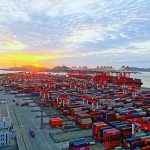The Korean shipbuilding industry’s share of global shipbuilding orders plummeted to less than 10 percent in May. This was blamed on a decline in orders for Korean shipbuilders’ main ship types including Liquefied Natural Gas (LNG) carriers.
Global ship orders totaled 1.8 million Compensated Gross Tonnage (CGT) in May, down 51 percent from 3.69 million CGT a year earlier, according to data released by Clarkson Research, a UK-based shipbuilding and shipping market research firm.
By country, China topped the standings with 1.54 million CGT (54 ships, 85 percent), followed by Korea with 170,000 CGT (2 ships, 10 percent).
Compared to the previous month, April, China’s order share climbed by 9 percentage points (from 76 percent to 85 percent), while Korea’s fell by 4 percentage points (from 14 percent to 10 percent). The gap in order shares between the two countries widened considerably from 62 percent in April to 75 percent in May.
Cumulative global orders in the January-May period of this year totaled 12.2 million CGT (726 vessels), up 6 percent from 19.07 million CGT (841 vessels) a year earlier. China accounted for 12.3 million CGT (479 ships and a 61 percent share), significantly outpacing Korea’s 5.61 million CGT (121 ships and a 28 percent share).
The global shipbuilding order backlog in May stood at 133.12 million CGT, with China posting 67.84 million CGT (51 percent) and Korea 39.07 million CGT (29 percent). Compared to the same period a year ago, China was up by 10.11 million CGT and Korea by 140,000 CGT.
The slump in Korea’s shipbuilding industry was caused by a decline in orders for LNG carriers and large container ships. LNG carriers and large container ships are Korean shipbuilders’ specialties. Large Korean shipbuilders such as HD Hyundai Heavy Industries, Hanwha Ocean, and Samsung Heavy Industries have mostly focused on LNG carriers, as their business portfolios are composed of high-value-added vessels whose construction requires state-of-art technology.
In the meantime, the Clarkson Newbuilding Price Index, an indicator of ship prices, stood at 186.42 at the end of May, up 10 percent from 170.01 in the same period of 2023. Ship prices by type were US $264 million for LNG carriers, US $130 million for Very Large Crude Carriers (VLCCs) and US $267.5 million for 22,000- to 24,000-TEU very large container ships.
Source: Hellenic Shipping News






